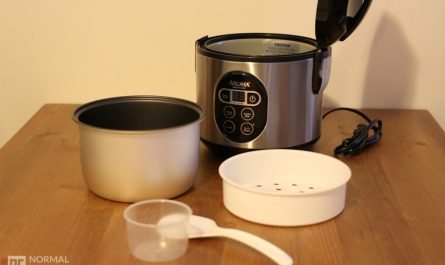Pressure cookers are pots that tightly seal the lid to build pressure for cooking. Most use rubber gaskets to create the seal. A valve releases pressure as needed to prevent it from building to the point that the lid is blown off. Pressure cookers can cook soups, stews, chili, and other foods in about 75% of time it would take to prepare them in a stock pot. The seal holds in more of the flavor of the foods you cook, and the faster cooking time preserves more of the vitamin and mineral content in foods and saves on energy costs. Using a pressure cooker for frothy or foamy foods is not recommended, however, because these foods can block the safety valves. Attempting to fry foods in a pressure cooker also is not recommended unless the manufacturer’s instructions approve that use.
In general, look for recently manufactured pots that include newer safety features. Older pots sold at garage sales and estate sales are potentially dangerous. Even in newer pots, there is the potential for the pressure valve to blow off if it is designed as a moving part. Heat resistant handles are an important feature as is a lid that opens easily once the cooking is done and the pressure is safely released.
Pressure cookers range from four to 10 quarts. Even if you are single and cook only for yourself, you might want to consider one that holds at least six-quarts because you can put the extra food you prepare in freezer containers or in blanched and frozen bell pepper shells. Thaw your frozen meal out later on days when you are too busy to cook or when you simply don’t feel like spending much time in the kitchen. Creating your own frozen dinners is much healthier than buying already prepared ones. If you are considering buying one, we recommend you don’t take your decision before reading our comprehensive reviews on the best pressure cookers.
Parts of a pressure cooker
A pressure cooker is made of a pot, a lid that fits precisely on the pot with a locking mechanism, a rubber ring that goes between the lid and the pot. This prevents the air from escaping the pot. A valve on top of the lid with a release whistle. The valve is a safety measure that makes sure the pressure inside the pot doesn’t reach dangerous levels. It’s designed to automatically let some of the pressure inside the pot escape to the outside, preventing explosions. On top of this paragraph you can see a visual representation found on this Youtube video.
How to clean a pressure cooker
The inside of your pressure cooker, while cooking, can become a really fragrant place. The PRDAL5 has a very heavy bottom, so hopefully burning and scorching won’t be an issue. However, it’s critically important to clean all the parts of the lid carefully to prevent “flavor hangover” from impacting your next dish.
- Don’t wait. Once it’s cool enough to touch, wash the top, including the gaskets and steam valve, immediately with warm running water and dish soap. Your pressure cooker works by boiling, so food and steam will collect on the lid.
- Loosen or remove and clean around the gasket after every use. This piece is critically important to the safety and effectiveness of your pressure cooker, and needs to be kept clean so it will stay flexible and safe.
- Don’t use a scratch pad on the gasket or any of the “soft” parts of your pressure cooker. Any small cuts you make in the gasket will be a catch-all for odor and grease in the future. Use de-greasing soap such as Dawn to remove any odors or food residue left on the gasket.
- Follow your manual for any cleaning or checking you need to make of the exhaust valve. It should be cleaned and cleared after each use. Do not allow starches to build up in the exhaust valve.
- The bottom pot may be cleaned by hand or in your dishwasher. For longevity, do not run gaskets through the dishwasher.
